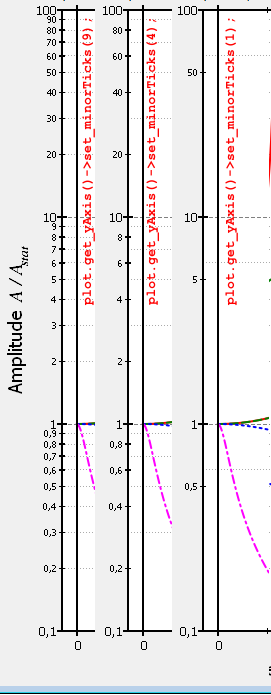mirror of
https://github.com/jkriege2/JKQtPlotter.git
synced 2024-11-16 02:25:50 +08:00
111 lines
6.3 KiB
Markdown
111 lines
6.3 KiB
Markdown
[Back to JKQTPlotter main page](https://github.com/jkriege2/JKQtPlotter/)
|
||
|
||
# JKQtPlotter
|
||
|
||
## Line Graph with Logarithmic y-axis
|
||
This project (see `./test/simpletest_logaxes/`) simply creates a JKQtPlotter widget (as a new window) and several line-graphs of different resonance curves.
|
||
|
||
The source code of the main application can be found in [`jkqtplotter_simpletest_logaxes.cpp´]((https://github.com/jkriege2/JKQtPlotter/blob/master/test/simpletest_logaxes/jkqtplotter_simpletest_logaxes.cpp). Mainly several graphs are generated in a loop and then different line styles are applied to the graphs (set by ``graph->set_style()`). The colors are set automtically from an internal default palette. The main loop looks like this:
|
||
|
||
```c++
|
||
QVector<Qt::PenStyle> pens {Qt::SolidLine, Qt::DashLine, Qt::DotLine, Qt::DashDotLine, Qt::DashDotDotLine };
|
||
for (int id=0; id<D.size(); id++) {
|
||
// generate some plot data
|
||
QVector<double> Y;
|
||
for (auto& xx: X) {
|
||
Y<<1.0/sqrt(sqr(1-sqr(xx))+sqr(2*xx*D[id]));
|
||
}
|
||
|
||
JKQTPxyLineGraph* graph=new JKQTPxyLineGraph(&plot);
|
||
|
||
// copy data into datastore and immediately set the yColumn
|
||
graph->set_xColumn(columnX);
|
||
graph->set_yColumn(ds->addCopiedColumn(Y, "y"+QString::number(id)));
|
||
|
||
// don't use symbols
|
||
graph->set_symbol(JKQTPnoSymbol);
|
||
// use one of different pens
|
||
graph->set_style(pens[id%pens.size()]);
|
||
// set width of graph line
|
||
graph->set_lineWidth(1.5);
|
||
|
||
// graph title is made from symbol+penstyle
|
||
graph->set_title(QString("D=\\delta/\\omega_0=%1").arg(D[id]));
|
||
|
||
// add the graph to the plot, so it is actually displayed
|
||
plot.addGraph(graph);
|
||
}
|
||
```
|
||
|
||
Then a `JKQTPgeoText` is added to the graph, which shows the function plotted in the plot:
|
||
```c++
|
||
// 4. Also we add a text-element in the plot to show the plotted function
|
||
// This element (JKQTPgeoText) is taken from the set of geometric elements
|
||
// and is simply parametrized by a position (1.25/10) and the text to display.
|
||
// In addition you can also set the font size (here to 15)
|
||
// Use '$...$' around the actual math string to ensure rendering with a math font
|
||
// (the internal renderer uses XITS fonts by default, which are free and auto-distributed
|
||
// and loaded in the library). If you don't use the math-mode modifiers, the default
|
||
// font of the other rendering text is used, which might not be suitable for
|
||
// high-quality math rendering.
|
||
plot.addGraph(new JKQTPgeoText(&plot, 1.25, 10, "$\\frac{A}{A_{stat}}=\\frac{1}{\\sqrt{\\left(1-\\eta^2\\right)^2+\\left(2{\\eta}D\\right)^2}}$", 15));
|
||
```
|
||
The difference between not using and using `$...$` for the equation can be seen here:
|
||
- no $-math-mode: 
|
||
- using $-math-mode: 
|
||
|
||
Finally the y-axis is switched to logarithmic scaling and the axis labels are set:
|
||
```c++
|
||
// 5. set y-axis to logarithmic (x-axis would be analogous, but using `plot.get_xAxis()`)
|
||
plot.get_yAxis()->set_logAxis(true);
|
||
// now we set the number of label ticks to 9 (you give the count if minor between two majors,
|
||
// so if you want ticks for 1,2,3,...,10,20,30,...,100... you need to use 9:
|
||
plot.get_yAxis()->set_minorTicks(9);
|
||
// the minor grid is not shown by default. You can switch it on:
|
||
plot.get_yAxis()->set_drawMinorGrid(true);
|
||
// usually axis ticks are shown as numbers 0.01, 0.1, 1, 10, ... You can also force the scientific
|
||
// power-of-10 notation, using:
|
||
plot.get_yAxis()->set_labelType(JKQTPCALTexponent);
|
||
// the number of digits in JKQTPCALTexponent determines which labels are drawn in standard-notation,
|
||
// as compared to power-notation (e.g. if set to 1, the labels 0.1=10^{-1}, 1, 10 are shown in
|
||
// standard notation, the rest in power-notation. This tweak improves readability)
|
||
plot.get_yAxis()->set_labelDigits(0);
|
||
// minor tick labels are usually not displayed, but you can switch them on, using
|
||
//plot.get_yAxis()->set_minorTickLabelsEnabled(true);
|
||
// the axis font sizes can be set with:
|
||
plot.get_yAxis()->set_tickLabelFontSize(10); // axis tick labels
|
||
plot.get_yAxis()->set_minorTickLabelFontSize(7); // minor axis tick labels
|
||
plot.get_yAxis()->set_labelFontSize(14); // axis label size
|
||
plot.get_xAxis()->set_tickLabelFontSize(10); // axis tick labels
|
||
plot.get_xAxis()->set_minorTickLabelFontSize(7); // minor axis tick labels
|
||
plot.get_xAxis()->set_labelFontSize(14); // axis label size
|
||
// ... and finally set axis labels (using LaTeX notation and $...$ to improve rendering)
|
||
plot.get_yAxis()->set_axisLabel("Amplitude $A/A_{stat}$");
|
||
plot.get_xAxis()->set_axisLabel("relative driving frequency $\\eta=\\omega/\\omega_0$");
|
||
```
|
||
|
||
As an alternative `JKQTPCALTexponentCharacter` does not use the power-of-10 notation, but uses the usual unit-characters, e.g. 0.001=1m, 0.000001=1µ, 10000=10k, ...
|
||
|
||
The result looks like this:
|
||
|
||

|
||
|
||
Without the logarithmic scaling we would have:
|
||
|
||

|
||
|
||
Switching the minor grid off results in a plot like this:
|
||
|
||

|
||
|
||
These examples show the results for different typical values for `set_minorTicks()`:
|
||
|
||

|
||
|
||
These examples show the results for different typical values for `set_labelType()`:
|
||
|
||

|
||
|
||
|
||
[Back to JKQTPlotter main page](https://github.com/jkriege2/JKQtPlotter/)
|